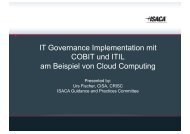Closed Loop Incident Process
Closed Loop Incident Process
Closed Loop Incident Process
Create successful ePaper yourself
Turn your PDF publications into a flip-book with our unique Google optimized e-Paper software.
<strong>Closed</strong>-<strong>Loop</strong> <strong>Incident</strong> Mgmt <strong>Process</strong><br />
<strong>Incident</strong> management from diagnosis to automated resolution<br />
1<br />
Identify service<br />
performance<br />
degradation<br />
2<br />
Troubleshoot<br />
problem to<br />
isolate root<br />
cause<br />
3<br />
Identify<br />
changes to be<br />
implemented<br />
4<br />
Create TT/RFC<br />
to implement<br />
change<br />
5<br />
Implement and<br />
automate<br />
change to close<br />
RFC<br />
6<br />
Update CMS<br />
(Federated<br />
CMCB)<br />
1. Identify service<br />
performance issue<br />
Business service<br />
management<br />
2. Gather data to identify<br />
root cause<br />
3. Create RFC to<br />
make change<br />
4b. Review, assess, plan and<br />
govern change<br />
IT service<br />
management<br />
4a. Initiate change<br />
5b. Close change<br />
request?<br />
6. Update Configuration Management System<br />
Configuration Management System (Federated CMDB)<br />
5a. Implement change<br />
Business service<br />
automation<br />
• Key processes—incident, change and configuration—need to be tightly linked<br />
• Seamless process linkage requires tools to be consistently service-oriented<br />
20







